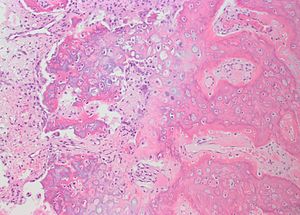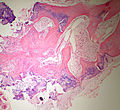Bizarre parosteal osteochondromatous proliferation
Jump to navigation
Jump to search
The printable version is no longer supported and may have rendering errors. Please update your browser bookmarks and please use the default browser print function instead.
| Bizarre parosteal osteochondromatous proliferation | |
|---|---|
| Diagnosis in short | |
 Bizarre parosteal osteochondromatous proliferation. H&E stain. | |
|
| |
| Synonyms | Nora lesion |
|
| |
| LM | disorganized cellular cartilage with a blue tint and patchy ossification matures into disorganized bone, proliferation of fibroblasts surrounds the bone/cartilage and occupies the intertrabecular spaces |
| LM DDx | periosteal chondrosarcoma, periosteal chondroma, low grade parosteal osteosarcoma, osteochondroma |
| Site | bone (see chondro-osseous tumours) - hands and feet |
|
| |
| Prevalence | rare |
| Prognosis | benign/locally aggressive |
Bizarre parosteal osteochondromatous proliferation, also known as Nora lesion, is a distinctive rare lesion of the hand or foot.[1]
General
A distinctive osteochondromatous proliferation of hands and feet.
Population:
- Young adults.
- Typically age (years) 20s and 30s.[1]
Prognosis:
- Benign.
- Locally aggressive.
Location
- Hands and feet.
Radiology
- Marginated wide based bony growth projecting into the soft tissues.[2]
Gross
- Nodule covered with glistening cartilage.
Microscopic
Features:
- Disorganized cellular cartilage with a blue tint and patchy ossification matures into disorganized bone. *Proliferation of fibroblasts surrounds the lesion and occupies intertrabecular spaces.
DDx:
- Periosteal chondrosarcoma.
- Periosteal chondroma.
- Low grade parosteal osteosarcoma.
- Osteochondroma.
Images
www:
Diagnostic categories
- Cartilaginous neoplasms.
- Osteocartilaginous neoplasms.
Molecular
- t(1:17)(q32;q21).[3]
Sign out
- BIZARRE PAROSTEAL OSTEOCHONDROMATOUS PROLIFERATION (NORA LESION).
- APPROPRIATE MARGIN STATEMENT.
See also
References
- ↑ 1.0 1.1 Gruber, G.; Giessauf, C.; Leithner, A.; Zacherl, M.; Clar, H.; Bodo, K.; Windhager, R. (Dec 2008). "Bizarre parosteal osteochondromatous proliferation (Nora lesion): a report of 3 cases and a review of the literature.". Can J Surg 51 (6): 486-9. PMID 19057740.
- ↑ URL: http://radiopaedia.org/articles/bizarre-parosteal-osteochondromatous-proliferation. Accessed on: 29 November 2014.
- ↑ Kuruvilla, S.; Marco, R.; Raymond, AK.; Al-Ibraheemi, A.; Tatevian, N. (2011). "BizarreParosteal Osteochondromatous Proliferation (Nora's lesion) with translocation t(1;17)(q32;q21): a case report and role of cytogenetic studies on diagnosis.". Ann Clin Lab Sci 41 (3): 285-7. PMID 22075515.





